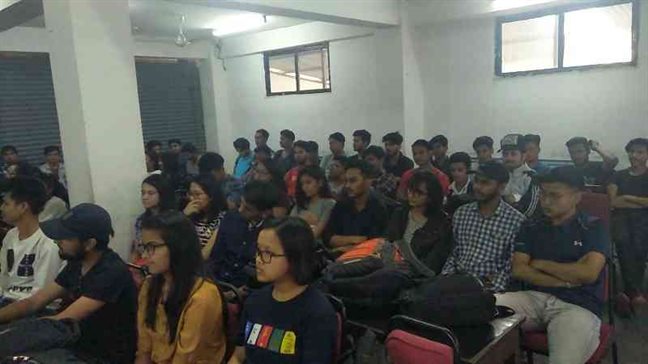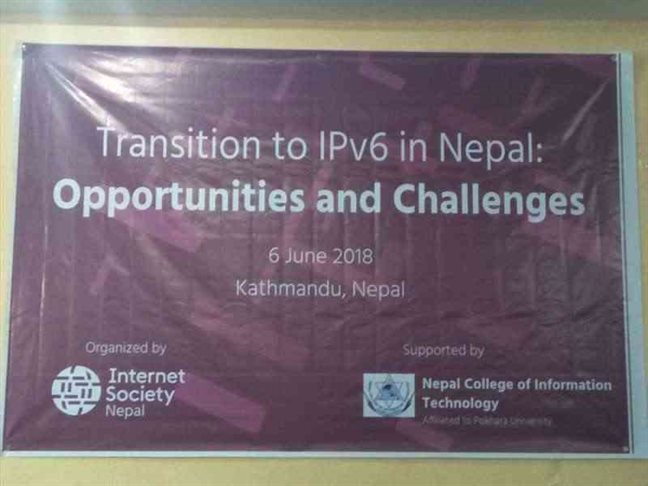Nepal Government Roadmap For IPv4 To IPv6 Network Migration Is A Must
The IPv6 day celebrated: Transition to IPv6 in Nepal opportunities and challenges. Marking the occasion of IPv6 day, Internet Society Chapter Nepal (ISN) has organized an event on ‘Transition to IPv6 in Nepal, opportunities and challenges’ at NCIT College, Balkumari, Lalitpur.
Internet Protocol Version 6 (IPv6) is an Internet Protocol (IP) used for carrying data in packets from a source to the destination over different networks. IPv6 is the enhanced version of IPv4 and can support huge numbers of nodes as compared to IPv4. It allows for 2128 possible node, or address, combinations.
The following are the features of the IPv6 protocol:
- New header format designed to keep header overhead to a minimum – achieved by moving both non-essential fields and optional fields to extension headers that are placed after the IPv6 header. The streamlined IPv6 header is more efficiently processed at intermediate routers.
- Large address space – IPv6 has 128-bit (16-byte) source and destination IP addresses. The considerable address space of IPv6 has been designed to allow for multiple levels of subnetting and address allocation from the Internet backbone to the individual subnets within an organization. The Obviates the need for address-conservation techniques such as the deployment of NATs.
- Very Efficient and hierarchical addressing and routing infrastructure- based on the frequent occurrence of multiple levels of Internet service providers.
- Stateless and stateful address configuration both in the absence or presence of a DHCP server. Hosts on a link automatically configure themselves with link-local addresses and communicate without manual configuration.
- Built-in security: Compliance with IPSec [10] is mandatory in IPv6, and IPSec is a part of the IPv6 protocol. IPv6 provides header extensions that ease the implementation of encryption, authentication, and Virtual Private Networks (VPNs). IPSec functionality is identical in IP Version 6 and IP Version 4, but one benefit of IP Version 6 is that IPSec can be utilized along the entire route, from source to destination.
- Better support for prioritized delivery thanks to the Flow Label field in the IPv6 header
- New protocol for neighboring node interaction- The Neighbor Discovery protocol for IPv6 replaces the broadcast-based Address Resolution Protocol (ARP), ICMPv4 Router Discovery, and ICMPv4 Redirect messages with efficient multicast and unicast Neighbor Discovery messages.
- Extensibility- IPv6 can easily be extended for new features by adding extension headers after the IPv6 header. [https://www.ipv6.com/general/ipv6-the-history-and-timeline/]
Ram Krishna Pariyar, Secretary of ISN and Krishna Prasad Pokharel, ExComm member of ISN made a presentation in an event regarding opportunities and challenges of IPv6 in Nepal.
The adaptation of IPv6 is less than 1 percent in Nepal informed Ram Krishna Pariyar. “All the contents in Nepal are stored in IPv4, that’s why embracing IPv6 can be meaningless”, added Pariyar.
In amid of the event Niranjan Khakurel, Principal of NCIT College encouraged students to research on Ipv6 very seriously because Nepal is yet unable to adopt IPv6 and one of the main reasons behind it is unskilled workforce.
Currently, companies like Google, Facebook, Cloudflare, and LinkedIn are using IPv6.
Krishna Prasad Pokharel listed down some of the challenges for IPv6 in Nepal. Here are some of the difficulties pointed by Pokharel regarding IPv6 in Nepal:
- Less demand for IPv6
- Still sufficient IPv4
- Lack of workforce
- Security concerns
- Investment
- Weak government policies
- Less focus on internet sources
The top 1,000 websites, as measured by Web analytics company Alexa, only 14.2 percent can be reached via IPv6 reports Pc world.
Source: http://ipv6-test.com/stats/country/NP
According to APNIC Labs statistics, IPv6 usage in Asia has jumped from 0.5% to 9.5% in the past five years, and in the Pacific, IPv6 usage has grown from 0.2% to 13.6% in the same period.
According to the report of International Journal of Science and Research prepared by Babu Ram Dawadi and Ananda Raj Khanal, the internet users and organizations of Nepal are not aware of the use of IPv6 in their services. ISPs are not in demand for IPv6 services to be offered by the customers. Some of the customers like banks and university network might have requested on IPv6 capable systems and applications. It is noticed that the knowledge and awareness about IPv6 and IPv6 ready equipment are minimal in the customer end; however, the new types of hardware and software purchased are already IPv6 capable.








